An Original and Exciting Book
by Michael Goeller
Modernized: The King’s Indian Defense, by Dejan Bojkov, Metropolitan Chess Publishing 2014, Figurine Algebraic Notation, Paperback, 365pp. $24.99 (ChessCafe Price: $21.27)
One of the most original King’s Indian repertoire books to appear in print is GM Dejan Bojkov’s Modernized: The King’s Indian Defense. I was so taken by the repertoire that I decided to check out some of GM Bojkov’s games with the lines he recommends, and I have written up Dejan Bojkov Plays the Modernized KID (in PGN) to give you an overview of his system.
Most repertoire books lead KID players toward a closed center to play for an attack on the kingside, as in the Mar del Plata Variation, which is most amateurs’ idea of the King’s Indian. But many different ways of playing the King’s Indian have emerged over the years. In my own quest to bring the KID back into my repertoire, I have been exploring a wide range of flexible systems, so I guess I have been very well prepared psychologically – sufficiently “modernized” you might say – to understand and appreciate a repertoire that focuses exclusively on fighting for the center, always seeking to blast open lines with pawn advances or sharp sacrifices. And while some of the lines where Black breaks in the center can result in potentially lifeless equality, they are clearly quite principled.
The contents is divided as follows:
- Introduction
- Chapter 1 The Classical Variation
- 1a Flexibility in the Classical Variation
- 1b The Gligoric System
- 1c The Exchange System
- 1d The Petrosian System
- Chapter 2 The Sämisch Variation
- Chapter 3 The Four Pawns Attack
- Chapter 4 The Averbakh System
- Chapter 5 The Bagirov Line
- Chapter 6 The Fianchetto System
- Solutions to the Exercises
- Index of Variations
Each chapter deserves some discussion:
Introduction (pp. 5-14)
The introduction might have been a good place to explain why Bojkov eschews more familiar KID territory for the “modernized” approach. Instead, he gives what reads like a personal argument for the beauties of the King’s Indian, commenting on the brilliant games Skembris-Van Wely, Skei 1993; Naumkin-Smirin, Ischia 1995; Kamsky-Kasparov, Manila ol 1992; Kotov-Gligoric, Zurich 1953; Avery-Gligoric, USA 1971; Miroshnichenko-Bojkov, Plovdiv 2008; Piket-Kasparov, Tilburg 1989; and Kramnik-Kasparov, Munich blitz 1994. While some of the lines and ideas in those games are reflected to some extent in the system that follows, fewer than half are directly relevant to the repertoire. So this chapter, while interesting in its own right for anyone who loves the KID, feels to me like a missed opportunity to present Bojkov’s brilliantly original concept of the book as a whole. A more focused introduction, in my view, might have pointed to the fight for the center theme and perhaps analyzed two great games of Kramnik’s: Kramnik-Ponomariov, Dortmund 2011 and Gustafsson-Kramnik, Dresden 2012 (one of the very few times Kramnik played the Black side of the KID); both games nicely illustrate the way the center-focused approach can be used against White’s Classical set-up.
1. The Classical Variation: 1.d4 Nf6 2.c4 g6 3.Nc3 Bg7 4.e4 d6 5.Nf3 O-O 6.Be2 e5 (pp. 15-120)

[FEN “rnbq1rk1/ppp2pbp/3p1np1/4p3/2PPP3/2N2N2/PP2BPPP/R1BQK2R w KQ – 0 7”]
2. The Sämisch Variation: 1.d4 Nf6 2.c4 g6 3.Nc3 Bg7 4.e4 d6 5.f3 O-O 6.Be3 c5 (pp. 121-188)

[FEN “rnbq1rk1/pp2ppbp/3p1np1/2p5/2PPP3/2N1BP2/PP4PP/R2QKBNR w KQ – 0 7”]
3. The Four Pawns Attack: 1.d4 Nf6 2.c4 g6 3.Nc3 Bg7 4.e4 d6 5.f4 O-O 6.Nf3 e5!? (pp. 189-212)

[FEN “rnbq1rk1/ppp2pbp/3p1np1/4p3/2PPPP2/2N2N2/PP4PP/R1BQKB1R w KQ – 0 7”]
4. The Averbakh System: 1.d4 Nf6 2.c4 g6 3.Nc3 Bg7 4.e4 d6 5.Be2 O-O 6.Bg5 Na6 (pp. 213-236)

[FEN “r1bq1rk1/ppp1ppbp/n2p1np1/6B1/2PPP3/2N5/PP2BPPP/R2QK1NR w KQ – 0 7”]
5. The Bagirov Line: 1.d4 Nf6 2.c4 g6 3.Nc3 Bg7 4.e4 d6 5.Nf3 O-O 6.h3 Na6!? (pp. 237-272)

[FEN “r1bq1rk1/ppp1ppbp/n2p1np1/8/2PPP3/2N2N1P/PP3PP1/R1BQKB1R w KQ – 0 7”]
6. The Fianchetto System: 1.d4 Nf6 2.c4 g6 3.Nc3 Bg7 4.Nf3 O-O 5.g3 d6 6.Bg2 c6 7.O-O Qa5 (pp. 273-306)

[FEN “rnb2rk1/pp2ppbp/2pp1np1/q7/2PP4/2N2NP1/PP2PPBP/R1BQ1RK1 w – – 0 8”]
Solutions to the Exercises (307-354)
When Al Lawrence designed Alburt and Chernin’s excellent Pirc Alert! book, he set the standard for effective opening training manuals. Modernized is the first I have seen, besides Lawrence’s other work for Alburt and company, to adopt some of those innovations – especially lots of diagrams, including “memory markers” and tactical exercises at the end of each chapter to assist with training. I especially appreciate the great tactical exercises, which are important for a repertoire build around tactical and positional themes.
Overall, this is a very exciting book. And while I might wish it had a more inspired introduction, maybe a better cover (Why lettering in all caps and dark against a dark background? And what is the cover image supposed to represent?), and one or two different sub-variations in the repertoire,Modernized: The King’s Indian Defense is a very sturdy and well-analyzed opening book – one that would be useful for players at all levels.
Here are some exercises from Bojkov’s own games.
Castaneda-Bojkov, Montreal 2012
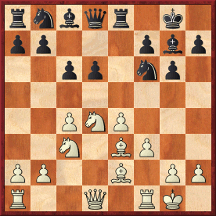
[FEN “rnbqr1k1/pp3pbp/2pp1np1/8/2PNP3/2N1BP2/PP2B1PP/R2Q1RK1 b – – 0 10”]
Vucic-Bojkov, ICC 3-minute 2005

[FEN “r1bqr1k1/pp1n1pb1/2pp1npp/8/2PNP2B/1PN2P2/P3B1PP/R2Q1RK1 b – – 0 12”]
Nordahl-Bojkov, Gothenburg 2005
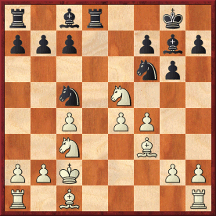
[FEN “r1br2k1/ppp2pbp/5np1/2n1N3/2P1PP2/2N2B2/PPK3PP/R1B4R b – – 0 12”]
Navara-Bojkov, Greece 2005
[FEN “r1bqr1k1/pp3pbp/5np1/3pn3/1P1NPP2/2N3PP/P7/1RBQRBK1 b – – 0 16”]
Castaneda-Bojkov, Montreal 2012
10…d5 “Of course, Black makes use of the fact that the Bishop on e3 is hanging, and clarifies the situation in the center. This is an immediate equalizer…” writes Bojkov.
Vucic-Bojkov, ICC 3-minute 2005
12…Qe7?! Of course, playing three–minute blitz it is easy to miss a shot – but it is very much like others that Bojkov illustrates in his wonderful book. 12…Nxe4!! 13.Bxd8 Nxc3 14.Qd2 Bxd4+ 15.Kh1 Nxe2 16.Rad1 (16.Rae1?! Bc3!) 16…Bc3 17.Qc2 Rxd8 18.Qxe2 Nc5-+.
Nordahl-Bojkov, Gothenburg 2005
12…Nfxe4! 13.Nxe4 Bf5 14.Re1 Bxe5! 15.fxe5 Rd4 16.Kc3 (only move)16…Rd3+ 17.Kc2 Rd4 18.Kc3 (only move) 18…Rd3+ 19.Kc2 Rd4 20.Kc3= ½–½
Navara-Bojkov, Greece 2005
16…Nxe4! 17.Nxe4 Nd7! 18.Nb5 dxe4 19.Qc2 Re6! 20.Bb2 Qb6+?![20…Bxb2! 21.Qxb2 a6 22.Nc3 (22.Nd4 Qb6) 22…Qb6+ 23.Kh2 Nf6 24.Bg2 Bd7 25.Nxe4 Nxe4 26.Rxe4 Rxe4 27.Bxe4 Bxh3! 28.Bxb7 (28.Kxh3 Qe6+) 28…Qxb7 29.Kxh3 Re8=/+.]
My assessment of this product: Great
Order Modernized: The King’s Indian Defense
by Dejan Bojkov
Rating Chart
- Awful – Utter rubbish
- Poor – Inferior
- Uneven – Mix of good and bad
- Good – Worth buying
- Great – Above average
- Excellent – Everyone should own
Leave a Reply